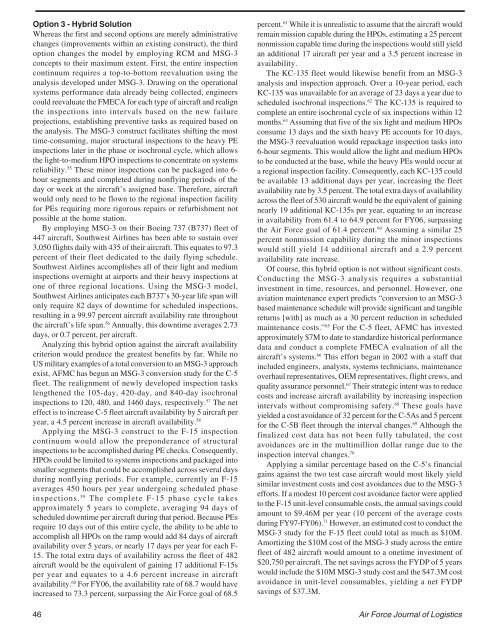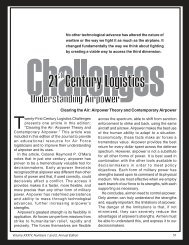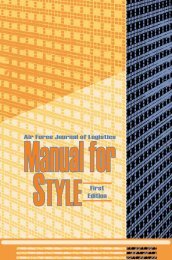Vol 32 No 4 - AF Logistics Management Agency
Vol 32 No 4 - AF Logistics Management Agency
Vol 32 No 4 - AF Logistics Management Agency
Create successful ePaper yourself
Turn your PDF publications into a flip-book with our unique Google optimized e-Paper software.
Option 3 - Hybrid Solution<br />
Whereas the first and second options are merely administrative<br />
changes (improvements within an existing construct), the third<br />
option changes the model by employing RCM and MSG-3<br />
concepts to their maximum extent. First, the entire inspection<br />
continuum requires a top-to-bottom reevaluation using the<br />
analysis developed under MSG-3. Drawing on the operational<br />
systems performance data already being collected, engineers<br />
could reevaluate the FMECA for each type of aircraft and realign<br />
the inspections into intervals based on the new failure<br />
projections, establishing preventive tasks as required based on<br />
the analysis. The MSG-3 construct facilitates shifting the most<br />
time-consuming, major structural inspections to the heavy PE<br />
inspections later in the phase or isochronal cycle, which allows<br />
the light-to-medium HPO inspections to concentrate on systems<br />
reliability. 55 These minor inspections can be packaged into 6hour<br />
segments and completed during nonflying periods of the<br />
day or week at the aircraft’s assigned base. Therefore, aircraft<br />
would only need to be flown to the regional inspection facility<br />
for PEs requiring more rigorous repairs or refurbishment not<br />
possible at the home station.<br />
By employing MSG-3 on their Boeing 737 (B737) fleet of<br />
447 aircraft, Southwest Airlines has been able to sustain over<br />
3,050 flights daily with 435 of their aircraft. This equates to 97.3<br />
percent of their fleet dedicated to the daily flying schedule.<br />
Southwest Airlines accomplishes all of their light and medium<br />
inspections overnight at airports and their heavy inspections at<br />
one of three regional locations. Using the MSG-3 model,<br />
Southwest Airlines anticipates each B737’s 30-year life span will<br />
only require 82 days of downtime for scheduled inspections,<br />
resulting in a 99.97 percent aircraft availability rate throughout<br />
the aircraft’s life span. 56 Annually, this downtime averages 2.73<br />
days, or 0.7 percent, per aircraft.<br />
Analyzing this hybrid option against the aircraft availability<br />
criterion would produce the greatest benefits by far. While no<br />
US military examples of a total conversion to an MSG-3 approach<br />
exist, <strong>AF</strong>MC has begun an MSG-3 conversion study for the C-5<br />
fleet. The realignment of newly developed inspection tasks<br />
lengthened the 105-day, 420-day, and 840-day isochronal<br />
inspections to 120, 480, and 1460 days, respectively. 57 The net<br />
effect is to increase C-5 fleet aircraft availability by 5 aircraft per<br />
year, a 4.5 percent increase in aircraft availability. 58<br />
Applying the MSG-3 construct to the F-15 inspection<br />
continuum would allow the preponderance of structural<br />
inspections to be accomplished during PE checks. Consequently,<br />
HPOs could be limited to systems inspections and packaged into<br />
smaller segments that could be accomplished across several days<br />
during nonflying periods. For example, currently an F-15<br />
averages 450 hours per year undergoing scheduled phase<br />
inspections. 59 The complete F-15 phase cycle takes<br />
approximately 5 years to complete, averaging 94 days of<br />
scheduled downtime per aircraft during that period. Because PEs<br />
require 10 days out of this entire cycle, the ability to be able to<br />
accomplish all HPOs on the ramp would add 84 days of aircraft<br />
availability over 5 years, or nearly 17 days per year for each F-<br />
15. The total extra days of availability across the fleet of 482<br />
aircraft would be the equivalent of gaining 17 additional F-15s<br />
per year and equates to a 4.6 percent increase in aircraft<br />
availability. 60 For FY06, the availability rate of 68.7 would have<br />
increased to 73.3 percent, surpassing the Air Force goal of 68.5<br />
46<br />
percent. 61 While it is unrealistic to assume that the aircraft would<br />
remain mission capable during the HPOs, estimating a 25 percent<br />
nonmission capable time during the inspections would still yield<br />
an additional 17 aircraft per year and a 3.5 percent increase in<br />
availability.<br />
The KC-135 fleet would likewise benefit from an MSG-3<br />
analysis and inspection approach. Over a 10-year period, each<br />
KC-135 was unavailable for an average of 23 days a year due to<br />
scheduled isochronal inspections. 62 The KC-135 is required to<br />
complete an entire isochronal cycle of six inspections within 12<br />
months. 63 Assuming that five of the six light and medium HPOs<br />
consume 13 days and the sixth heavy PE accounts for 10 days,<br />
the MSG-3 reevaluation would repackage inspection tasks into<br />
6-hour segments. This would allow the light and medium HPOs<br />
to be conducted at the base, while the heavy PEs would occur at<br />
a regional inspection facility. Consequently, each KC-135 could<br />
be available 13 additional days per year, increasing the fleet<br />
availability rate by 3.5 percent. The total extra days of availability<br />
across the fleet of 530 aircraft would be the equivalent of gaining<br />
nearly 19 additional KC-135s per year, equating to an increase<br />
in availability from 61.4 to 64.9 percent for FY06, surpassing<br />
the Air Force goal of 61.4 percent. 64 Assuming a similar 25<br />
percent nonmission capability during the minor inspections<br />
would still yield 14 additional aircraft and a 2.9 percent<br />
availability rate increase.<br />
Of course, this hybrid option is not without significant costs.<br />
Conducting the MSG-3 analysis requires a substantial<br />
investment in time, resources, and personnel. However, one<br />
aviation maintenance expert predicts “conversion to an MSG-3<br />
based maintenance schedule will provide significant and tangible<br />
returns [with] as much as a 30 percent reduction in scheduled<br />
maintenance costs.” 65 For the C-5 fleet, <strong>AF</strong>MC has invested<br />
approximately $7M to date to standardize historical performance<br />
data and conduct a complete FMECA evaluation of all the<br />
aircraft’s systems. 66 This effort began in 2002 with a staff that<br />
included engineers, analysts, systems technicians, maintenance<br />
overhaul representatives, OEM representatives, flight crews, and<br />
quality assurance personnel. 67 Their strategic intent was to reduce<br />
costs and increase aircraft availability by increasing inspection<br />
intervals without compromising safety. 68 These goals have<br />
yielded a cost avoidance of <strong>32</strong> percent for the C-5As and 5 percent<br />
for the C-5B fleet through the interval changes. 69 Although the<br />
finalized cost data has not been fully tabulated, the cost<br />
avoidances are in the multimillion dollar range due to the<br />
inspection interval changes. 70<br />
Applying a similar percentage based on the C-5’s financial<br />
gains against the two test case aircraft would most likely yield<br />
similar investment costs and cost avoidances due to the MSG-3<br />
efforts. If a modest 10 percent cost avoidance factor were applied<br />
to the F-15 unit-level consumable costs, the annual savings could<br />
amount to $9.46M per year (10 percent of the average costs<br />
during FY97-FY06). 71 However, an estimated cost to conduct the<br />
MSG-3 study for the F-15 fleet could total as much as $10M.<br />
Amortizing the $10M cost of the MSG-3 study across the entire<br />
fleet of 482 aircraft would amount to a onetime investment of<br />
$20,750 per aircraft. The net savings across the FYDP of 5 years<br />
would include the $10M MSG-3 study cost and the $47.3M cost<br />
avoidance in unit-level consumables, yielding a net FYDP<br />
savings of $37.3M.<br />
Air Force Journal of <strong>Logistics</strong>





